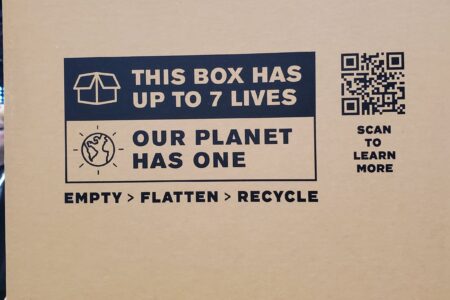Brands: beware of the new class of private label products

Credit: Waitrose/Walmart
There’s a trendy new product on the shelf attracting a lot of consumer attention and it’s not from a national or multinational brand — it’s a store-owned/private label brand.
In a recent webinar entitled, “The Private Label Revolution: Is CPG having a Netflix Moment?”, Nik Modi, global co-head of consumer/retail equity research and HBC, beverage and packaged food analyst, RBC Capital Markets, LLC, and Hunter Thurman, founder/president, of consumer psychology and behaviour consultancy, Alpha Diver, discussed the growth of private label products within consumer packaged goods (CPG) and the impact they are having on branded CPG products.
Historically PL products have been used by lower income consumers and by higher income consumers when times were tough so they would ‘trade down’, but the latter would ‘trade up’ again when the situation improved. But, Nik Modi, said this time it’s different. “The percentage household penetration for private label products has increased over the past few quarters and has surpassed pre-Covid levels,” he said, noting that PL has experienced broad market share gains.
Modi said that a 2023 study showed that about USD $1.5 billion worth of sales shifted away from national brands and sales have also shifted from the grocery channel to the rest of food channels (discount, mass, club) where PL brands sales growth notably outpaced national brand sales growth. “The percentage price gap between PL and branded players has been volatile but is recently on a downward trend approaching the lowest levels seen since 2019,” he said, adding that while this should be good for brands, the problem is that the branded price is still really high. For consumers today, Modi explained, it’s not about trending down, about trending out.
Furthermore, the percentage of household penetration of PL CPG is correlated with age cohort, with higher penetration in households of older individuals, but currently, noted Modi, Gen X consumers have the highest buy rate. He also shared that baby boomers are also heavily involved in PL product. “Companies do not market to them anymore but baby boomers have the most disposable income because they have no one they need to spend money on but themselves. Brands tend to forget about them but baby boomers will big chunk of spending over next few years,” said Modi. (Sidenote, Modi said it is because of Japan’s large baby boomer population that the country is the biggest luxury market in the world.)
Over the long term, PL is projected to gain 5 pts of dollar share by 2030. And although beverages have historically had low PL participation, it is gaining market share as branded beverages continue to see comps loss.
Retailer initiatives are ramping up and becoming more sophisticated and AI is being overlaid to help them make better decisions. “There is a major shift happening in PL — perception changing, the market, category and industry is changing. Backward looking isn’t going to help,” said Hunter Thurman, president and founder of Alpha Diver.
Thurman said what happened with Netflix 20 years ago is happening with PL brands today. “Netflix used to offer knock DVD rentals, cheap, & convenient. Pl in the past offered knock-off products, cheaper. Then Netflix began to offer a new kind of entertainment: on-demand which elevated the frame of reference to cable TV. PL products introduced a new kind of brand: cross category and attractive prices that engaged a new kind of shopper. And while Netflix started offering original, exclusive content, PL brands are offering innovative exclusive products,” he said, adding that “no one saw the ‘Netflix disruptor’ coming when it first emerged.”
“Private label/store brands are the new disruptors—they can innovate faster than the national [multinational] brands, said Thurman. “We need to banish the ‘trade down to store brand’ mentality. Modern store brands are far from knockoffs, and it’s changing shopper psychology and decision-making. A new type of shopper is being engaged and it’s changing the marketplace. Realty is that a new type of shopper is being engaged via these store brands.”
Gone are the days of ‘national vs store brand’, today, Thurman says there are three types of brands: national, owned brands and value brands. To consumers, there is little difference between ‘national’ and ‘owned brands’.
Target Stores (favorite day) and Amazon (Aplenty) launched PL brands in spring that are on-point with current trends. Walmart launched bettergoods in April — a new PL brand focused on quality, unique, chef-inspired food items at an affordable price. “This brand does more than just compete on price. This is very different than what we’ve seen at Walmart because it is not entirely a price-based proposition,” said Modi. “bettergoods is offering trendier, unique products, not just about higher prices, different foods and flavours that even national brands are not offering.”
bettergoods is competing in categories such as coffee, dairy, non-dairy (almond milk), beverages, snacks, chocolate, etc. Interestingly, Modi noted that from an income point of view, those in the USD $125K+ income bracket are showing the highest household penetration by a wide margin thus far in the launch of bettergoods. “Walmart has recruited a lot of higher income households into their stores over the last couple of years. This is a way for them to keep these types of consumers.”
Both Modi and Thurman noted that with their unique, on-trend offerings, PL/store brands are engaging the growing, ever-important, ethnically diverse Gen Z consumer.
“Consumers today are not buying PL/’owned brands’ because they are cheaper, they are interested in them,” said Thurman. “Owned brands are creating more excitement so attracting the coveted shoppers, not about trading down on price. We must stop thinking about national vs PL/owned brand in such a binary way.”



